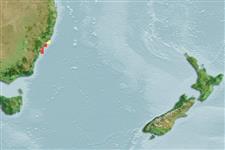>
Syngnathiformes (Pipefishes and seahorses) >
Syngnathidae (Pipefishes and seahorses) > Syngnathinae
Etymology: lumnitzeri: This species is named after A. Lumnitzer, who collected the type specimens..
Environment: milieu / climate zone / depth range / distribution range
Ecologie
marien rifbewoner; standvastig; diepte 6 - 30 m (Ref. 54742). Subtropical
Southwestern Pacific: known from the Sydney region (Clovelly, Cronulla and Botany Bay) and Jervis Bay.
Grootte / Gewicht / Leeftijd
Maturity: Lm ? range ? - ? cm
Max length : 5.5 cm TL mannelijk / geslacht onbekend; (Ref. 54742)
Korte beschrijving
Morfologie | Morfometrie
Dorsale stekels (totaal): 0; Dorsale zachte stralen (totaal): 15-16. Superior trunk and tail ridges discontinuous; rings 11 + 43-44; subdorsal rings 2.5 + 1.5; head length 86-91% of trunk length, and angled ventrad approximately 25° from longitudinal axis of body; trunk length 18-20% TL; snout length 2.2-2.6 in HL; top of head with prominent, tall, frontal ridge. Coloration: white to dark grey wit brown to red blotches or irregular banding; sometimes uniformly burgundy-red. Fleshy appendages mostly red with grey branches or tips.
Found in semi-exposed rocky reefs, sparsely covered with bushy red-algae in which the species is extremely well camouflaged (Ref. 54742). Benthic species (Ref. 75154).
Levenscyclus en paargedrag
Maturiteit | Voortplanting | Paaien | Eieren | Fecunditeit | Larven
Male carries the eggs in a brood pouch (Ref. 205).
Kuiter, R.H., 2004. A new pygmy pipehorse (Pisces: Syngnathidae: Idiotropiscis) from eastern Australia. Rec. Aust. Mus. 56:163-165. (Ref. 54742)
Status op de Rode Lijst van het IUCN (Ref. 130435)
Gevaar voor de mens
Harmless
Gebruik door de mens
Meer informatie
Leeftijd/GrootteGroeiLengte-gewichtLengte-lengteLengtefrequentiesMorfometrieMorfologieLarvenLarvale populatiedynamiekRekruteringAbundantieBRUVS
ReferentiesAquacultuurAquacultuurprofielKweeklijnenGeneticaElectrophoresesErfelijkheidZiektesVerwerkingNutrientsMassaconversie
Tools
Speciale rapporten
Download XML
Internetbronnen
Estimates based on models
Preferred temperature (Ref.
123201): 20.8 - 21.4, mean 21.2 °C (based on 4 cells).
Fylogenetische diversiteitsindex (Ref.
82804): PD
50 = 0.6250 [Uniqueness, from 0.5 = low to 2.0 = high].
Bayesian length-weight: a=0.00037 (0.00016 - 0.00085), b=3.18 (2.99 - 3.37), in cm total length, based on LWR estimates for this (Sub)family-body shape (Ref.
93245).
Trofisch niveau (Ref.
69278): 3.2 ±0.4 se; based on size and trophs of closest relatives
Weerstandsvermogen (Ref.
120179): Hoog, minimale populatieverdubbelingstijd minder dan 15 maanden (Preliminary K or Fecundity.).
Fishing Vulnerability (Ref.
59153): Low vulnerability (10 of 100).
Nutrients (Ref.
124155): Calcium = 208 [86, 686] mg/100g; Iron = 1.89 [0.73, 4.05] mg/100g; Protein = 18.4 [16.7, 20.0] %; Omega3 = 0.19 [0.06, 0.61] g/100g; Selenium = 27.1 [6.7, 89.6] μg/100g; VitaminA = 30.1 [4.9, 182.3] μg/100g; Zinc = 2.5 [1.2, 4.5] mg/100g (wet weight);
